Alekhine’s Simultaneous Exhibition:
Sofia, Bulgaria April 1936
by Tomasz Lissowski
|
|
| Champion Alexander Alekhine’s visit in April 1936
to Sofia was a memorable event for the many Bulgarian chess amateurs who
saw him. The maestro came to the capitol of Bulgaria with his wife,
Mrs. Grace Wishart, and her inseparable Siamese cat, the famous “Chess.”
The couple, in the company of some representatives of Sofia chess circles,
toured the city. The main point of the great player’s schedule, however,
was a simultaneous chess exhibition, where Alekhine met a strong field
that included, to name only two, Tsvetkov and Kiprov, who later played
in the 1939 Chess Olympiad in Buenos Aires (Buenos Aires was the first
appearance for the Bulgarian team in such an event; if we ignore
the non-FIDE Olympiad held in Munich 1936.) |
| The event, played on April 13, 1936, saw Alekhine
facing forty opponents, two of them blindfold. He won twenty-seven
games, drew nine, and lost four. As so often happens with such displays,
the games preserved disproportionately include the single player’s draws
and losses. In this case, of the five games that have been found,
Alekhine lost two and drew the other three. None of his victories
have so far been recovered. |
|
Alekhine,A — Tanielian,A
|
Simul
|
| A40/09 |
Irregular Queen’s Pawn: Owen
|
|
|
1.e4 c6 2.d4 b6 3.c4 Bb7 4.Nc3 e6 5.d5 exd5 6.cxd5 Bb4
7.Bd3 cxd5 8.exd5 Bxc3+ 9.bxc3 Bxd5 10.Nf3 Nf6 11.Ba3 Qc7 12.0-0 Nc6 13.Re1+
Be6 14.Ba6 Ne7 15.Bd6 Qc6 16.Bxe7 Kxe7 17.Nd4 Qc5 18.Qf3 Rhd8 19.Rab1 Kf8
20.h3 Qc7 21.a4 Bd5 22.Qd3 Re8 23.Nb5 Qc5 24.Qg3 Ne4 25.Qh4 g5 26.Qxh7
Qxf2+ 27.Kh2 Qg3+ 28.Kg1 Nf6 29.Rxe8+ Rxe8 30.Qc2 Be4 0-1.
|
Alexander Alekhine’s Chess Games, 1902-1946,
Skinner & Verhoeven 1998, p558
|
|
|
Alekhine,A — Tsvetkov,A
|
Simul
|
| C10/11 |
French: Rubinstein
|
|
|
1.e4 e6 2.d4 d5 3.Nc3 dxe4 4.Nxe4 Nd7 5.c3 Ngf6 6.Ng3
c5 7.Nf3 Be7 8.Be3 0-0 9.Bd3 Qc7 10.Qc2 b6 11.Ng5 h6 12.Nh7 Re8 13.Nxf6+
Nxf6 14.0-0 Bb7 15.dxc5 Qc6 16.f3 Nd5 17.Bf2 Bxc5 18.Rae1 Rad8 19.Ne4 Bxf2+
20.Rxf2 Nf4 21.Bf1 Qd5 22.Rd2 Qxa2 23.Bb5 Rf8 24.Nd6 Bd5 25.Ne4 Qa5 26.Bf1
b5 27.g3 Qb6+ 28.Kh1 Ng6 29.Bg2 a5 30.b3 Rc8 31.Qb2 Rc7 32.h4 Rfc8 33.h5
Ne7 34.Rd3 Nf5 35.Kh2 Rc6 36.f4 Qc7 37.Qd2 Bxe4 38.Bxe4 Rxc3 39.Rd7 Qb6
40.g4 Ne3 41.Rg1 Rc2 42.Bxc2 Rxc2 43.Qxc2 Nxc2 44.g5 Ne1 45.Rg3 hxg5 46.fxg5
Kf8 47.Rd2 Qc6 48.Rf2 Qe4 49.Kh3 Nd3 0-1.
|
Alexander Alekhine’s Chess Games, 1902-1946,
Skinner & Verhoeven 1998, p558
|
|
|
Alekhine,A — Kiprov,A
|
Simul
|
| D06/01 |
Queen’s Gambit: Marshall
|
|
|
1.d4 d5 2.c4 Nf6 3.cxd5 Nxd5 4.e4 Nf6 5.Nc3 e6 6.Nf3 c5
7.Bb5+ Nbd7 8.0-0 a6 9.Be2 Be7 10.d5 exd5 11.exd5 Nb6 12.Bg5 Nbxd5 13.Nxd5
Qxd5 14.Qxd5 Nxd5 15.Bxe7 Nxe7 16.Ne5 0-0 17.Bf3 Rb8 18.Rfe1 Be6 19.Nd3
Nf5 20.Nxc5 Nd4 21.Be4 Rfc8 22.b4 Nc6 23.a3 Rc7 24.Rac1 Nd8 25.f4 Rbc8
26.Rcd1 g6 27.Rd6 Kf8 28.Rb6 a5 29.Kf2 axb4 30.axb4 Bd7 31.Bd5 Nc6 32.Rc1
Be8 33.Nxb7 Ne7 34.Rxc7 Rxc7 35.Be4 Nc8 36.Ra6 Rc4 37.Bd5 Rxf4+ 38.Ke3
Rxb4 39.Nc5 Ne7 40.Bf3 Nf5+ 41.Kd2 Nh4 ½-½.
|
Alexander Alekhine’s Chess Games, 1902-1946,
Skinner & Verhoeven 1998, p558
|
|
|
Alekhine,A — Voinov,N
|
Simul
|
| B83/02 |
Sicilian: Scheveningen
|
|
|
1.e4 c5 2.Nf3 Nc6 3.d4 cxd4 4.Nxd4 e6 5.Be2 d6 6.0-0 Nf6
7.Nc3 Be7 8.b3 a6 9.Bb2 Qc7 10.Kh1 Nxd4 11.Qxd4 b5 12.a4 e5 13.Qd3 b4 14.Nd5
Nxd5 15.exd5 f5 16.a5 Bf6 17.Qd2 0-0 18.Bc4 Qc5 19.c3 bxc3 20.Bxc3 Rb8
21.Qe2 Bd7 22.f4 e4 23.Bxf6 Rxf6 24.Bxa6 Rxb3 25.Bc4 Rc3 26.a6 Rf8 27.Rfc1
Rxc1+ 28.Rxc1 Bb5 29.a7 Bxc4 30.Qxc4 Qxa7 31.h3 Qe3 32.Rf1 Qc5 33.Qxc5
dxc5 34.Rc1 Rc8 35.d6 c4 36.Kg1 Kf7 37.d7 Rd8 38.Rxc4 Rxd7 39.g4 Ke6 40.Rc5
fxg4 41.hxg4 Re7 42.Re5+ Kf6 43.Rf5+ Ke6 44.Kf2 Kd6 45.Ke3 Kc6 46.Ra5 ½-½.
|
Alexander Alekhine’s Chess Games, 1902-1946,
Skinner & Verhoeven 1998, p558
|
|
|
Alekhine,A — Radoslavov,A
|
Simul
|
|
1.e4 c6 2.d4 d5 3.exd5 cxd5 4.c4 Nf6 5.Nc3 e6 6.Nf3 Be7
7.Bd3 dxc4 8.Bxc4 a6 9.0-0 0-0 10.Re1 b5 11.Bd3 Bb7 12.Bf4 Bd6 13.Ne5 Nc6
14.Nxc6 Bxc6 15.Be5 Qe7 16.Qe2 Bxe5 17.dxe5 Nd5 18.Qe4 g6 19.Qg4 Nxc3 20.bxc3
Bd5 21.a4 Rac8 22.axb5 axb5 23.Rac1 Bc4 24.Be4 Rc5 25.f4 Bd5 26.Qe2 Bxe4
27.Qxe4 Rc4 28.Qe3 Rfc8 29.h3 Qc5 30.Rb1 Rxc3 31.Qxc5 R3xc5 32.Kf2 Rb8
33.Rb4 Rc4 34.Reb1 Rxb4 35.Rxb4 f6 36.Ke3 fxe5 37.fxe5 Kf7 38.Kd4 Rd8+
39.Ke4 Rd5 40.Rb2 Ke7 41.h4 Kd8 42.g4 Kc7 43.h5 gxh5 44.gxh5 Kb6 45.Kf4
½-½.
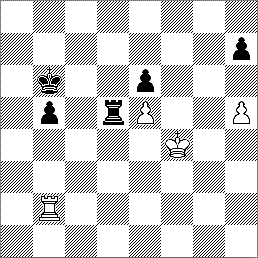
|
Alexander Alekhine’s Chess Games, 1902-1946,
Skinner & Verhoeven 1998, p558
|
|
| As we see, the courteous Bulgarians did not want
to “torture” Alekhine, and here or there accepted draws despite holding
a material advantage. |
| The scores printed above are well known and perhaps
by themselves are not worthy of detailed recollection. Here, though,
they are the essential background for publishing, for the very first time,
a collection of photographs that might well be entitled “Alekhine in Sofia.”
The story about how the collection came into existence is told by its owner,
Polish journalist Stefan Rusiecki: |
| “One of my ancestors, Stanislaw Rusiecki, emigrated
from Poland in 1863 for political reasons. Many refugees chose France
for exile, some chose England, but he escaped to Romania. Stanislaw’s
grandson, Ryszard Rusiecki, whose mother was Polish, was born in Bucharest
in 1900. He was my grandfather. He finished his studies in
the Academy of Economics in Varna, and could speak fluent French, Russian
and German, besides Polish and Bulgarian. After graduation he worked
as an employee of a certain German company’s representative office and
later was nominated Commercial Attaché in the newly opened Polish
Embassy in Sofia. In the 1930s my grandfather was very keen on chess
composition. He probably had earlier played some practical chess,
though he never mentioned it. Here are two of his best works, from
a total of 130: |
R. Rusiecki
Match Sofia - Province 1953
Mate in 2
1. Place
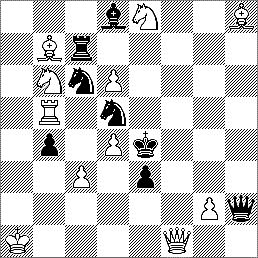
Key: 1. Na4
|
R. Rusiecki
SVTVS 1953
Mate in 3
4. Honorary mention
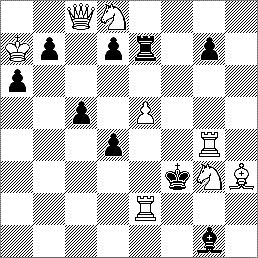
Key: 1. Nf7 (1...Rxf7 2.Qxb7+; 1...Be3 2.Qxc5)
|
| In grandfather’s old photo album rests more than
ten photographs documenting Alekhine’s visit to Sofia. One of them,
the largest, was made in a professional studio, and shows Alekhine surrounded
no doubt by Bulgarian officials and players, my grandfather among them.
At the bottom appears Alekhine’s autograph and the date: April 16, 1936. |
|
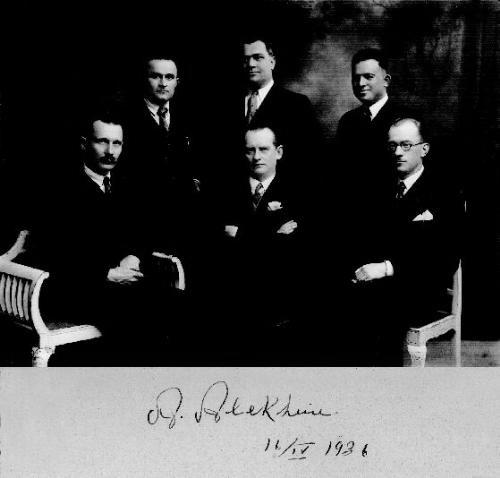
A. Alekhine with Bulgarian chess players and officials; To his left,
R. Rusiecki.
|
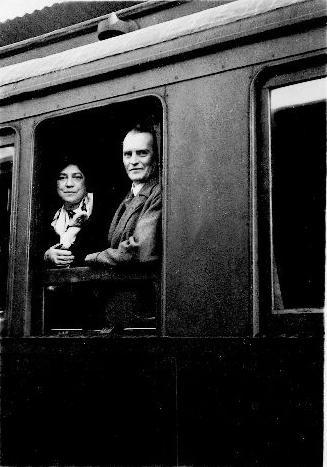
Alekhine, his wife, and their famous cat, “Chess,” arrive in Sofia.
|
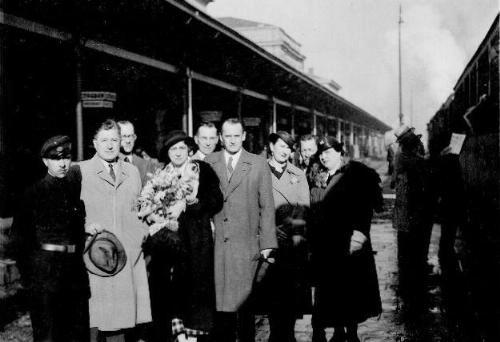
Arrival in Sofia. Mrs. Wishart with her cat and flowers.
On her right hand, R. Rusiecki; in the middle, A. Alekhine.
|
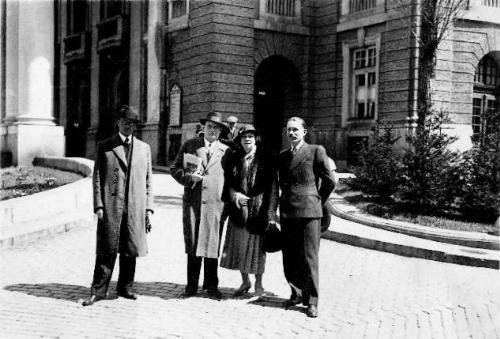
From left to right: R. Rusiecki, A. Alekhine, Mrs. Wishart, NN.
|
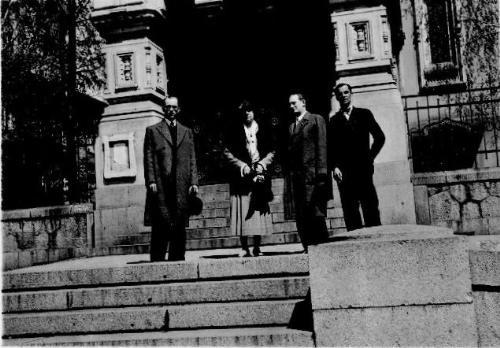
Sightseeing in Sofia. From the left: R. Rusiecki, Mrs. Wishart, A.
Alekhine, NN.
|
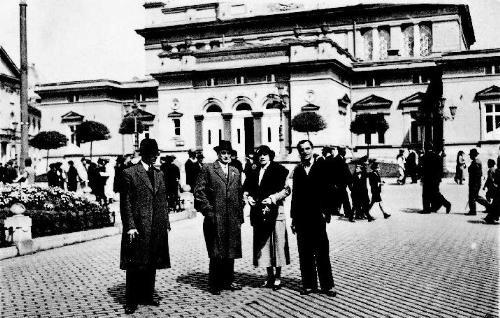
Sightseeing in Sofia. From the left: R. Rusiecki, A. Alekhine, Mrs
Wishart, NN.
|
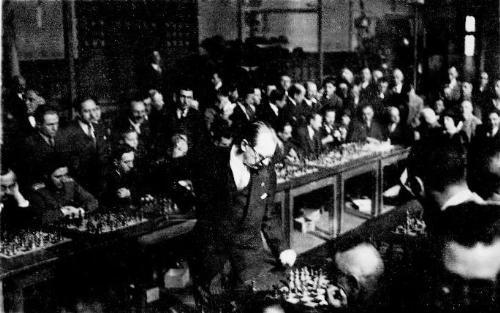
Simultaneous exhibition in Sofia - the beginning of the display.
|
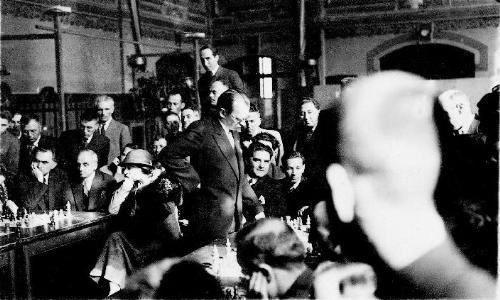
Simultaneous exhibition in Sofia - Alekhine in the middle.
|
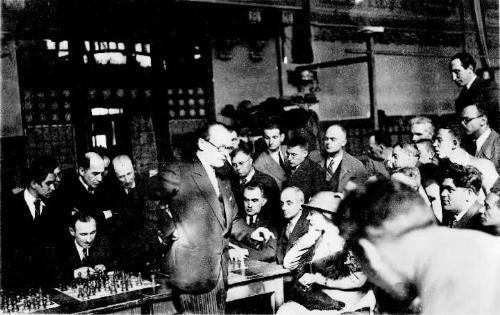
Simultaneous exhibition in Sofia - Alekhine in the middle.
|
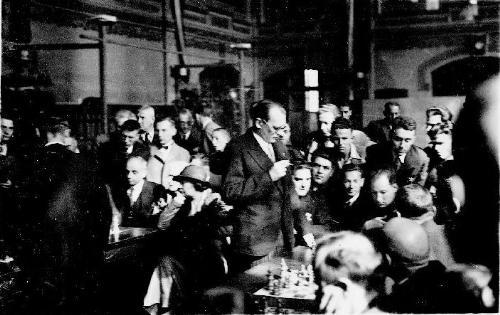
Simultaneous exhibition in Sofia - the last games.
|
| As can be seen, my grandfather guided Alekhine and
his wife in touring the city. His skill with languages obviously
proved useful in this instance.” |
|
| Ryszard Rusiecki’s mission in Sofia ended in 1953.
Both before the second World War as well as after he edited various chess
columns in Bulgarian newspapers and magazines: Niva (1929-1931),
Kamboma
(1934-1935), Dnes (1935-1936) and Rebus (1947-1948).
He died on December 25, 1986, in Warsaw. The photographs collected
by this businessman, diplomat and chess composer, form a worthy addition
to the story of the fourth world chess champion. |
|
© Tomasz Lissowski 2000
|
